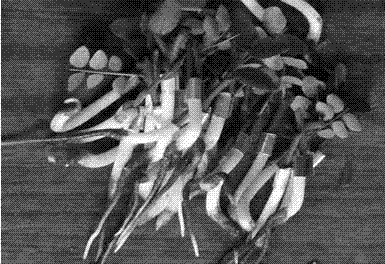Chinese honey locust bud seedling twig grafting method
A technology of sprouts and honey locusts, which is applied in the field of grafting of honey locust sprouts, can solve the problems of many thorns, slow grafting speed, and high cost of the honey locust branches, and achieve the effects of accelerating the promotion speed, shortening the cultivation time, and improving the grafting efficiency
- Summary
- Abstract
- Description
- Claims
- Application Information
AI Technical Summary
Problems solved by technology
Method used
Image
Examples
Embodiment 1
[0024] The invention discloses a method for grafting twigs of acacia buds. The buds cultivated from acacia seeds are used as rootstocks, and the semi-lignified twigs of the improved species of acacia are used as scions, which are grafted by split grafting and grow into new plants. The operation method and steps are as follows:
[0025] 1. Rootstock cultivation
[0026] 1.1 Seed Harvesting
[0027] Choose a strong tree with vigorous tree vigor, well-developed, no pests and diseases, and a 30-100-year-old fruiting period with full seeds. Seeds are collected when the fruit turns reddish-brown from late October to early November. Choose full mature pod horns, dry them after harvesting, grind (roll) crushed pod horns to get seeds, remove impurities, choose plump seeds with large grains, no insects, no diseases, and no mechanical damage as seeds. The thousand-grain weight of the seeds is 450-500 grams , dry storage for winter, spare.
[0028] 1.2 Sulfuric acid treatment
[0029]...
PUM
 Login to View More
Login to View More Abstract
Description
Claims
Application Information
 Login to View More
Login to View More - R&D
- Intellectual Property
- Life Sciences
- Materials
- Tech Scout
- Unparalleled Data Quality
- Higher Quality Content
- 60% Fewer Hallucinations
Browse by: Latest US Patents, China's latest patents, Technical Efficacy Thesaurus, Application Domain, Technology Topic, Popular Technical Reports.
© 2025 PatSnap. All rights reserved.Legal|Privacy policy|Modern Slavery Act Transparency Statement|Sitemap|About US| Contact US: help@patsnap.com


